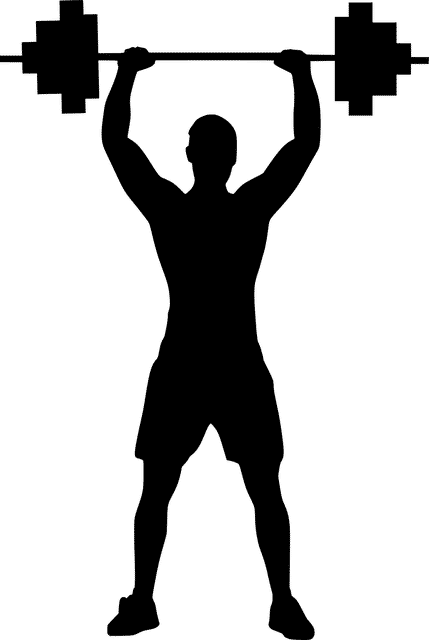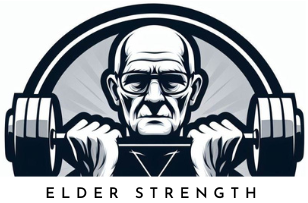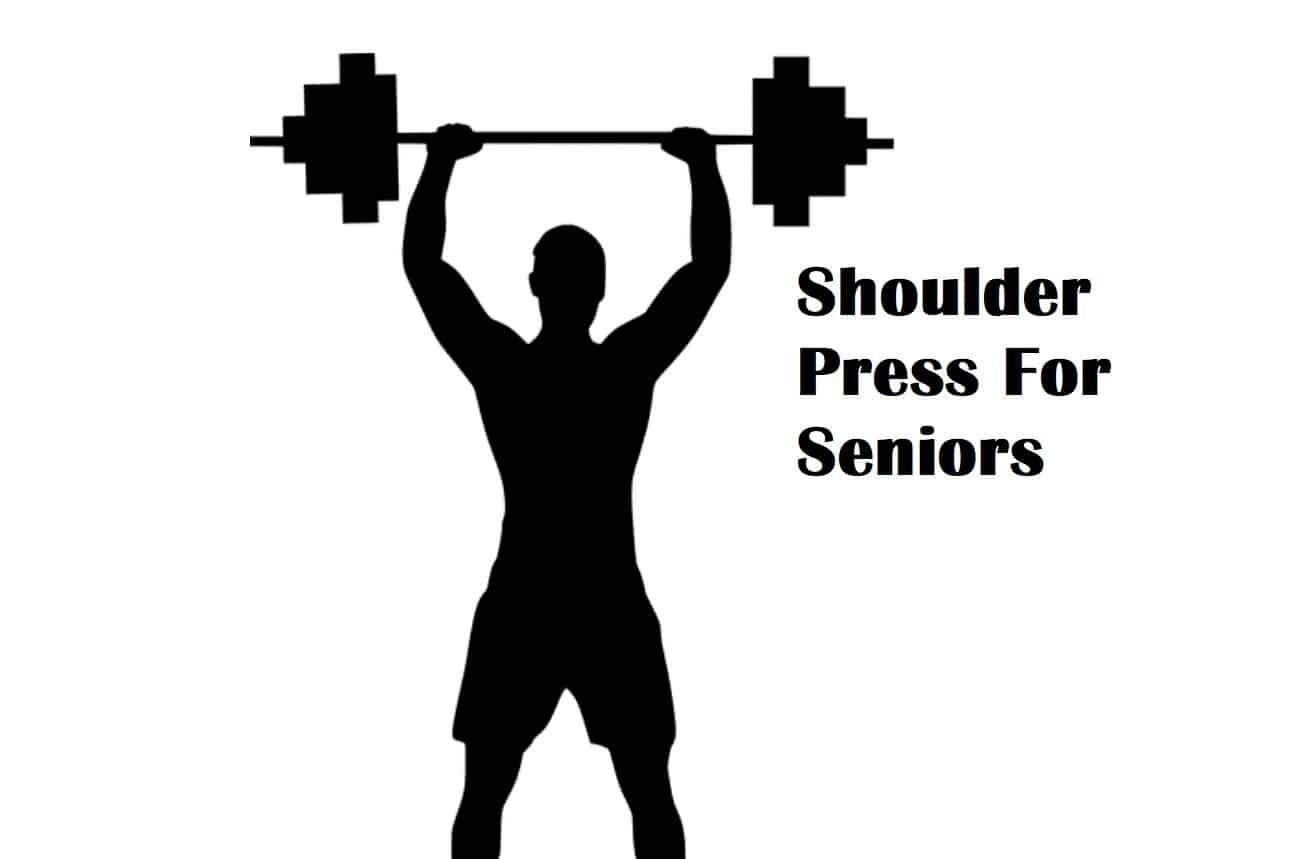In this post, you will learn about the shoulder press for seniors. The shoulder press is a movement that develops your overhead strength, something that many seniors struggle with. Read on to find out why the shoulder press is a great exercise for seniors!
Need to lift that heavy box of family treasures to the top shelf but you simply can’t get the box above your head? Maybe helping to unload the attic but you soon realize even lifting your arms above your head seems too hard? I’m sure you can imagine the situation or you’ve been there.
Even if you are relatively strong, as in, strong enough to be able to do all your day to day chores and be active, the chances are that your overhead strength is weak.
This is because most people rarely do anything above their heads. Or at least anything that requires any significant strength.
This is all fine until you have to actually lift something heavy over your head. You’d be surprised how many people can’t even lift their own hands over their head straight and keep them there for several seconds without their shoulders giving out.
The chances are that if you have not practiced lifting heavy objects above your head you can’t lift anything substantial above your head safely. In the worst-case scenario, you can injure your shoulder or even lose balance and drop the object on your head.
Both scenarios are clearly unwanted so what can you do? You can strengthen your overhead strength by performing overhead presses of course!
Shoulder presses are the most functional way to strengthen your shoulder because they allow you to gradually increase the weight you can lift above your head in a very real-life fashion.
I.e. the strength your generate with shoulder presses
What is a shoulder press
The shoulder press is also known as simply “the press”, military press, overhead press and probably a bunch of other names I’m not aware of.
They all mean the same movement pattern. Lifting a weight from the level of your shoulders to above your head. While this seems simple enough, a lot of things have to happen right to perform this correctly.

It’s very common to see even young otherwise physically fit people who can’t perform overhead presses correctly due to lack of strength and mobility. It’s very common to see people lifting the weights slightly in front of instead of directly above you.
This is possible to do with lighter weight but as the weight gets heavier, you can’t lift the weight without foxing your form because of the leverage the weight creates in front of you.
Correctly performed shoulder press keeps the weight perfectly balance over the center of your gravity. If you are performing a standing press this will be in the middle of your foot and if you are performing a seated press, this will be in a perfect line above your shoulders and torso.
The shoulder press can be performed with dumbells, barbells, kettlebells and in a standing or a sitting position. For most seniors either a standing barbell press (with a lighter bar) or a seated dumbbell press will be optimal.
The shoulder press is a full-body movement, meaning you will have to control your whole body, not just your arms and shoulders. The strength is partially produced by making a solid platform to press from.
How to perform the shoulder press
The standing barbell shoulder press is performed as follows:
- The lift starts with the barbell at the chest. Either touching the clavicles or slightly off the chest, supported by your arms.
- Elbows are pointing down
- Head is back (to make room for the bar to pass), midsection and glutes are tight
- The bar is lifted in a straight line upwards
- Once the bar passes the face, the head is pushed forward
- The lift is completed by pushing the barbell above the head in a straight line. Shoulders and elbows fully extended.
- The lift is reversed by bringing the head back and dropping the barbell to the chest in a controlled manner
Here’s a great explanation by Mark Rippetoe on the Art of Manliness Youtube channel (YouTube embed, content not owned or created by ElderStrength.com):
Mark Rippetoe is the author of the Starting Strength program that’s helped thousands of people, including seniors get stronger. You can learn more about Starting Strength in the article Starting Strength For Seniors – How To Get Started,
Seated Shoulder Presss
The seated dumbbell shoulder press is performed as follows:
- The lift starts in a seated position on a bench or a chair
- The head is neutral and the dumbells are on both sides of the head
- Midsection and legs are tight
- The dumbbells are pressed straight overhead (no need to move your head out of the way)
Here’s a great explanation of the seated dumbbell variation by ScottHermanFitness (YouTube embed, content not owned or created by ElderStrength.com):
Muscles involved in a shoulder press
Like I said a moment ago, the shoulder press is a full-body movement. Even the seated variation but especially a standing overhead press.
The main moving muscles are the deltoids and the triceps. They are the large muscles of your shoulders and upper arms that are responsible for pushing upwards.
Because the press is a functional movement with a long kinetic chain, it actually activates your whole body as a stabilizer. To effectively push a heavy weight overhead, you will have to maintain a rigid posture to push against. This is also great for balance.
The “core” or the muscles of the abdomen and midsection, as well as the glutes, are in an exceptionally crucial role in stabilizing your body.
Also, the whole upper back and the shoulder girdle have to remain in a good posture to successfully perform a shoulder press. At the top of the movement, the traps will aid in shrugging your shoulders up to allow a full extension of the shoulder joint.
So essentially is a shoulder press is a shoulder movement that actually uses the whole body. That’s what makes it so effective. It’s probably the most useful of all strength exercises right after the deadlift.
Is shoulder press beneficial for seniors?
Yes, the shoulder press is very beneficial for seniors. This is because many seniors lack overhead strength, have shoulder pain and mobility issues.
To perform the press correctly, you will need enough shoulder and upper back mobility. This means that before you can actually start increasing the weight on the press, you will have first make sure you can perform the movement correctly.
If you find out you simply can’t lift your arms above your head in a straight line at first, don’t get discouraged. This is very normal.
The best way to improve your shoulder mobility enough to perform a shoulder press is to use a broom handle or a similar stick, and attempt to perform shoulder presses with it daily.
You will soon find your range of motion improves until you can perform the movement with perfect form. This is the first point you should even consider adding weight to the exercise.
The shoulder press can improve your overhead strength dramatically even if done with a lightweight if you perform them correctly.
This will help protect your shoulders from injury, improve your posture, improve your balance and offer most of the benefits of strength training in a single exercise.
Free weight exercises are great for seniors because they develop functional strength and improve balance. This makes the overhead a great fall prevention exercise for seniors as well.
Conclusion
I hope you found this tutorial for the shoulder press useful and will incorporate the movement into your own exercise routine. There really isn’t a better exercise for strengthening the shoulder and improving overhead strength.
The best part is that this strength is very useful in real life as it will make real-life chores like lifting items from and to top shelves easier and safer while improving your health and protecting your shoulders.
Performing the overhead press will also increase your overall strength, making day-to-day chores easier and making heavy items easier to carry.
There really is no reason to not include this excellent exercise in your routine if you want to actually improve the strength and functionality of your body. So get pressing!
If you enjoyed this article, please subscribe to my newsletter and bookmark this site. Social shares are also much appreciated!
See you next time!

